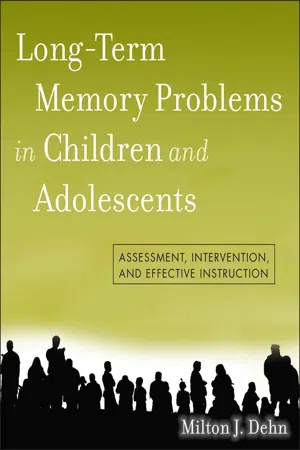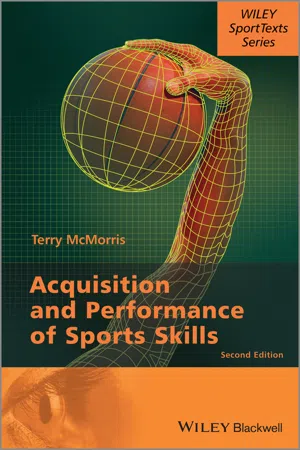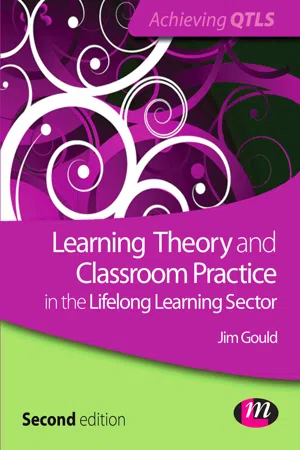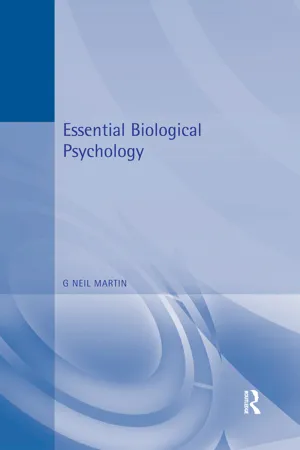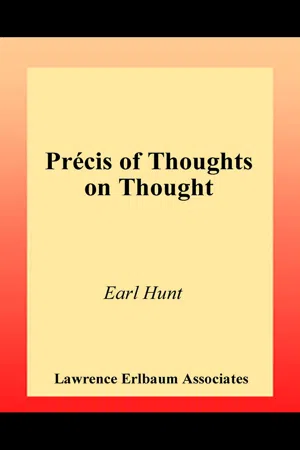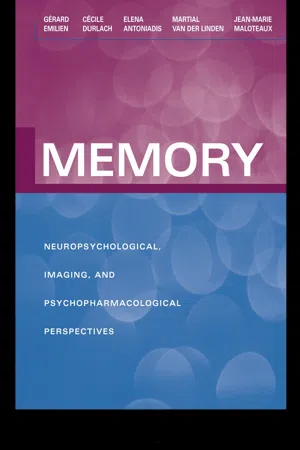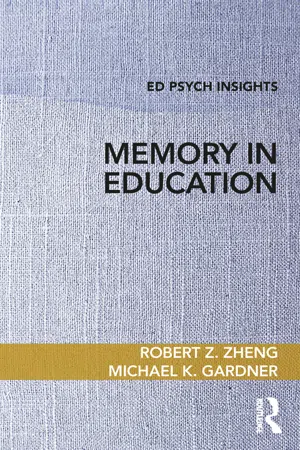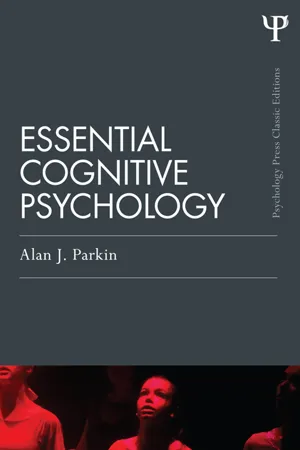Psychology
Memory
Memory refers to the mental processes involved in encoding, storing, and retrieving information. It encompasses various types of memory, including sensory, short-term, and long-term memory. Memory plays a crucial role in cognitive processes such as learning, problem-solving, and decision-making.
Written by Perlego with AI-assistance
Related key terms
11 Key excerpts on "Memory"
- eBook - ePub
Long-Term Memory Problems in Children and Adolescents
Assessment, Intervention, and Effective Instruction
- Milton J. Dehn(Author)
- 2010(Publication Date)
- Wiley(Publisher)
Human Memory systems have different functions and handle distinct types of information. Not only do separate Memory systems deal with distinct kinds of information, but they operate according to different principles and rely on different neural structures and processes (Tulving, 1993). Nonetheless, each cognitive event or learning experience draws on a unique combination of components from one or more Memory systems. That is, there is seldom a one-to-one correspondence between the information being encoded and a particular Memory system. However, Memory systems can operate independently of one another. For instance, an individual who appears to have total amnesia for explicit forms of Memory can still learn and remember through the implicit (unconscious) Memory system. Despite the diversity of storage systems, a common set of cognitive processes enables much of the encoding, storage, and retrieval of information.The purpose of this chapter is to help readers begin to unravel the complexities and mysteries of human Memory and to gain an understanding of how all the pieces and processes work in unison. The chapter will begin by discriminating among short-term, working, and long-term Memory, and by examining the components of each. The discussion will then focus on the divisions of long-term Memory, with emphasis on the types of Memory most closely related to academic learning. Details on all of the Memory processing from input to output will then be provided, along with a discussion of forgetting and some cognitive theories of Memory organization. By the end of the chapter the reader should have a grasp of Memory fundamentals and begin to foresee assessment possibilities and educational implications. This chapter focuses on cognitive models of Memory, whereas Chapter 3 describes Memory functions from a neurological perspective.THE FLOW OF INFORMATION
Memory has been investigated since the early days of psychology (Ebbinghaus, 1913), but only in recent decades have psychologists reached a consensus about its structures and functions. There was even uncertainty over the division of Memory into short-term and long-term components until early neuropsychological studies in the 1940s confirmed the distinction. Building on this finding, cognitive models of Memory and information processing originated in the 1950s and evolved into the elaborate multi-component models that are now supported by neuroscientists’ brain imaging research. It is difficult to represent complex human Memory structures and functions in a figure, and consequently the general information processing model has been criticized as being overly simplified. Nonetheless, the classic model (see Figure 2.1 - Nancy Fenton, Jessica Flitter(Authors)
- 2015(Publication Date)
- Research & Education Association(Publisher)
Chapter 9 CognitionPsychology involves the scientific study of the behavior and mental processes of humans and animals. The term cognition refers to the mental processes portion of the study of psychology and can be translated simply to mean thinking. The term thinking alone, however, does not do justice to the complex and varied processes that comprise cognition. Cognitive psychologists investigate the wide range of processes that make up thinking, including perception, Memory, attention, reasoning, language, and problem solving. Cognitive neuroscientists take the study of thought even further to determine the neural processes and brain regions responsible for various types of cognitions. This chapter on cognition addresses four of the largest and most integrated areas of cognitive research: Memory, language, thinking, and problem solving.MemoryMemory is the cognitive process that allows individuals to retain knowledge of information and events and is the result of three processes: encoding, storing, and retrieving. Cognitive psychologists investigating Memory examine the process in terms of information processing , or how information travels through the nervous system, including perception, Memory creation, reasoning, and formulating responses. Information-processing theorists have presented a variety of stage models to explain human cognition, but the theory that has received the most attention is the Atkinson and Shiffrin information-processing model of Memory.The three-stage information-processing model of Memory , developed by Atkinson and Shiffrin, describes Memory as a sequential process moving through three distinct stages: sensory Memory, short-term Memory, and long-term Memory. A visual representation of this model is represented in Figure 9.1. Information flows from one stage to the next as it is encoded, stored, and retrieved. The original concept of short-term Memory within this model has been expanded by Alan Baddeley and renamed working Memory and consists of additional components. Within the working Memory model there is a central executive that controls and directs attention through a visuospatial sketchpad (visual picture) and phonological loop (verbal rehearsal). In addition, the central executive also coordinates the information transfer between working Memory and long-term Memory through the episodic buffer- eBook - ePub
- John Henderson(Author)
- 2005(Publication Date)
- Routledge(Publisher)
Atkinson and Shiffrin, 1968 ). This is by no means an exhaustive list.Whatever the terminology, distinctions exist between types of Memory thought to be responsible for different functions. The following chapters generally use a psychological approach but make frequent reference to information processing and physiological function. They take as their point of departure the distinctions used in Atkinson and Shiffrin’s multi-store model. In this information-processing model, information must register biologically, for example in the case of visual information, an image must fall on the light-sensitive surface of the retina of the eye or sound waves must impinge upon the timpanum of the ear. Psychologically, this information is then carried in a limited-capacity sensory store from which it will disappear shortly. If it needs to be used further, however, it must be moved into a conscious store, also of limited size, where it may be worked with in the short term whilst it is needed. If the information is likely to be needed again, it may be stored more permanently in the long term. We will scrutinise this model closely in Chapter 3 .Review exercise List five approaches to the study of Memory. Try to think of at last one advantage and disadvantage associated with each approach.Chapter summary
When reading a psychology book, it is easy to think about the concepts that are involved only in a psychological way. It has been suggested in this chapter that alternative approaches to the study of Memory processes should not be ignored, so that the student may be able to think more broadly about what might be involved when information needs to be processed.Further reading
- Blakemore, C. (1990) The Mind Machine . London: BBC Books. The work of Kandel, Lashley, Hebb, Morris and Parkin mentioned in this chapter is dealt with effectively in the Mind Machine
- eBook - ePub
- Terry McMorris(Author)
- 2014(Publication Date)
- Wiley(Publisher)
7 MemoryLearning objectives
At the end of this chapter, you should be able to:- define Memory
- understand the nature of the sensory information store, short term Memory and long-term Memory
- understand the differences between declarative and non-declarative long-term Memory
- know the brain regions involved in Memory
- know the main developmental factors involved in Memory.
In this chapter, we examine what, to the Information Processing theorists, is the basis of their theory, namely Memory. Tulving (1985) described Memory as being the ‘capacity that permits organisms to benefit from their past experiences’ (p. 385). This definition covers all types of Memory: verbal, visual, emotional and motor. In this text, we are interested in verbal and visual Memory, especially where they aid learning. We are, of course also, interested in motor Memory. Motor Memory could be described as the ability to consistently reproduce a skill over a period of time. Even ecological psychologists accept that this happens.As well as being broken down into verbal, visual and motor subgroups, Memory has been divided into sensory information store, STM, LTM and working Memory. We have discussed the nature and role of working Memory in decision making, in Chapter 3 , so we will not spend time on it here. Suffice it to say that working Memory includes inputs from both STM and LTM. That STM and LTM are different entities is not universally accepted. Evidence that there are differences between STM and LTM comes mostly from studies with individuals who have suffered some form of brain damage. Some patients have demonstrated significant negative effects on STM with no effect on LTM, while others have demonstrated the opposite.Information processing theory and short-term Memory
Sensory information store
The sensory information store (SIS) holds all incoming information for a brief time. Most of the information is lost within 0.5 s. It is only retained and processed if it is attended to. The retained information is the selectively attended to stimuli. According to Atkinson and Shiffrin’s (1968) modal model of Memory, if this information is to pass to STM, it must be rehearsed. I do not like the use of the word rehearsal, with regard to Memory, but we will come across it again. To most people rehearsal includes a physical element. In these terms it does not necessarily, although it could do. Rehearsal really means being attended to, or processed mentally and/or physically. More recent evidence shows that not all attended to information needs to be passed to STM, some is passed directly to LTM. In fact, the ‘attention’ does not even have to be conscious, it can be undertaken at a sub-conscious level. How this occurs is examined in Chapter 8 - Jim Gould(Author)
- 2012(Publication Date)
- Learning Matters(Publisher)
10
Memory and learning
Chapter overview and objectives
The ability to retain and later access the information we encounter is crucial to the process of learning. Without Memory, we would not be able to draw on previous experience, seen in Chapter 9 to be essential in the performing of functions ranging from those as basic as recognising letters on a page to those as complex as decision-making. Memory provides the link between the past, the present and the future, and is a crucial stage in the process of learning. This chapter explores models of Memory and their implications for practice.When you have worked through this chapter you will be able to:- identify the three different processes involved in Memory;
- differentiate between sensory Memory, short-term Memory, long-term Memory and working Memory;
- identify the mechanisms at work in each of the above types of Memory and how these relate to the processes of Memory;
- describe the ‘levels of processing’ approach to Memory;
- recognise the importance of organisation, meaning and understanding in committing information to long-term Memory;
- recognise that forgetting occurs for reasons of decay, displacement, retrieval failure or interference;
- match reasons for forgetting to different components of the Memory system;
- describe strategies for improving Memory;
- list the different types of mnemonic devices that might be used to assist retrieval of information from long-term Memory;
- describe the basic concepts of cognitive neuroscience and how these apply to Memory.
Memory processes
Memory is an information storage system and the way in which it works can be compared with another information storage system – the filing cabinet. Suppose you receive your new TV licence and wish to put it into your filing cabinet for safe keeping. The first stage in this process would be to decide what to file it under and this would depend upon how you had organised your filing cabinet in the first place. You may have organised it so that it contains files headed ‘entertainment’, ‘household’ and ‘legal documents’. Under which of these categories will you file your TV licence? You decide to file it under ‘entertainment’ and place it into the appropriate folder to be stored until you need it again. When information is first received for storage in Memory, a decision must also be made as to how and where it will be stored. This process is analogous to deciding what to file the information under and is known as encoding. Encoding normally involves changing the information into a form in which it can be subsequently stored.- eBook - ePub
- G Neil Martin(Author)
- 2015(Publication Date)
- Routledge(Publisher)
7 Learning and MemoryWhat You Will Find in This Chapter
- ■ a description of the basic types of learning
- ■ a description of the biology underlying some of these types of learning
- ■ an evaluation of the role of neurotransmitters and synapses in the formation of Memory
- ■ a definition of Memory and of the different types of Memory process
- ■ an evaluation of the role of the hippocampus and the cortex in Memory
What You Should Be Able to Do after Reading the Chapter
- ■ be aware of what psychologists describe as learning
- ■ be aware of the different types of learning
- ■ outline the changes in the synapse that reflect the formation of Memory
- ■ understand that there are different types of Memory, and that each may be the responsibility of different brain regions or processes
- ■ be aware of the consequences of hippocampus and diencephalon damage on Memory
- ■ describe the brain regions highlighted by neuroimaging studies as being active during specific Memory tasks
7.1 Learning and Memory Defined
What is Memory? This is a simple question that probably invites a simple answer, but the more you think about it, the more complex the answer becomes. Humans show evidence of Memory, as do animals. Even organisms with a primitive nervous system – such as the sea slug, Aplysia – can learn and show evidence of 'Memory'.Memory is a process, rather than a thing or an entity, and refers to the cognitive process involved in acquiring and retrieving material. This material could be verbal or pictorial such as the words on the page of this book or pictures from a manual showing you how to install jour DVD or video recorder; it could be event-related (the circumstances of an accident or a recent trip to the cinema); or it could be skill-based (riding a bike, driving a car or typing on a computer keyboard). All of these different types of Memory suggest that Memory is not a unitary process, and it is not. The type of Memory involved in recalling personally meaningful events, for example, seems to be different to that which involves recalling the names of capital cities or previous British prime ministers. The type of Memory involved in learning to use a computer is different to that involved in temporarily holding a telephone number in mind as you dial it. - eBook - ePub
- Earl Hunt(Author)
- 2002(Publication Date)
- Psychology Press(Publisher)
5 Memory5.1 Overview of the Chapter
Thinking depends on Memory, for if we had no memories learning would be impossible. Cognition would quite literally be reduced to knee-jerk reactions! We may complain about forgetting because we set such high standards for ourselves. Anderson (1990) used analytic techniques originally developed to evaluate information storage systems, such has libraries, to evaluate remembering. He concluded that human Memory is an almost optimal solution to the problem of utilizing limited resources in order to retrieve the information we are likely to need, when we need it.Any information retrieval system, including human Memory, processes information in three stages. In the encoding stage information is abstracted and indexed for later retrieval. Encoding always represents a guess about how information is to be used, for the memorizer has no way of knowing the context in which a piece of information will be needed. In the second stage, storage, information has to be stored until it is needed. Storage has two aspects. The information itself must be maintained and its place in the indexing system must be protected. Whether or not information is ever physically lost from human Memory is debatable, and perhaps unknowable. We clearly do suffer from distortions in indexing. To illustrate, I invite the reader to recall his or her telephone number, three jobs or houses ago. Finally, in the retrieval stage the system must respond to a request for information. Cues present in the request are used to construct a retrieval path that will lead through the indexing system to the needed information.When Memory fails it can be hard to determine the stage in which the failure occurred. Suppose you have the common, embarrassing experience of forgetting a person’s name. Is this because you never attended to his or her name when you were introduced (encoding failure), because you have since met several other individuals who look like this person (storage failure due to changes in indexing), or because you cannot think, right at this moment, of any cues to suggest a name (retrieval failure)? Understanding Memory is one of the major goals of cognitive psychology. The task demands and deserves rigorous analyses. - eBook - ePub
Memory
Neuropsychological, Imaging and Psychopharmacological Perspectives
- Gérard Emilien, Cécile Durlach, Elena Antoniadis, Martial Van der Linden, Jean-Marie Maloteaux(Authors)
- 2004(Publication Date)
- Routledge(Publisher)
Part I Neuropsychology and Pharmacology of Memory
Passage contains an image
1 What is Memory?
INTRODUCTION
In Memory research, the initial impact of an experience on the brain has been called an engram (Schacter, 1996). Trace theory describes an encoding process in which the engram or Memory trace has both a gist (a general notion) and specific details (Schacter, 1996). With time, the details of an experience may begin to fade away and become less tightly bound together. However, the gist may remain quite accurate and easily accessible for retrieval. When trying to retrieve an original Memory, one may be calling up the gist at first and then later trying to reconstruct the details. This reconstruction process may be profoundly influenced by the present environment, the questioning context itself, and other factors such as current emotions (Christianson, 1991).Remembering past events involves a large number of processes and their identification and interaction continues as a primary goal of today’s Memory research. One major set of these processes concerns “ecphory” (recovery of stored information); another has to do with what is called episodic “retrieval mode” or REMO (Nyberg et al., 1995; Tulving, 1983). REMO refers to a neurocognitive set or state, and is a basic and pivotal necessary condition for remembering past events. Memory is an active process in which even the most concrete experiences are actually dynamic representational processes. Remembering is not merely the reactivation of an old engram. It is the reconstruction of a new neural-net profile with features of the old engram and elements of Memory from other experiences, as well as influences from the present state of mind. This is particularly important for clinicians when interviewing patients about past events, including trauma. The gist of a situation may be recalled with great accuracy but the details may be more subject to bias from ongoing experiences. - eBook - ePub
- Robert Z. Zheng, Michael K. Gardner(Authors)
- 2019(Publication Date)
- Routledge(Publisher)
TwoInformation Processing Model of Human Memory
During the 1960s, cognitive psychologists began to explore how people process information. They were heavily influenced by the advent of computers and tried to identify similarities between human information processing and computer information processing. The process went something like this: (a) environmental stimuli exist in the external world and are detected by sensory organs such as the eyes, ears, nose, and skin surface; (b) this sensory information is held briefly in a sensory Memory so that it can be identified as meaningful objects, and so on; (c) the identified information is stored in a time-limited, short-term Memory—here the information can be transformed and processed; (d) the information can then be transferred to a relatively permanent long-term Memory, where it can be stored until needed in the future; and (e) the information in long-term Memory, combined with information in short-term Memory, can give rise to responses, which is the way the individual effects his or her environment.By 1968, this had been summarized by Richard Atkinson and Richard Shiffrin into what has been termed “the modal model of Memory” (see Figure 2.1 ).2 ,3As can be seen in the figure, human Memory had been divided into three qualitatively different types of Memory. It is perhaps best to discuss each of these Memory stores in greater detail.Figure 2.1 The Modal Model of MemorySensory Memory
When external information enters the information processing system, it is held by a sensory Memory. There is likely a sensory Memory for each of the senses, but the two most extensively studied sensory stores are those for visual and auditory information. These are sometimes referred to as iconic Memory (for the visual system) and echoic Memory (for the auditory system). The existence of a sensory Memory was demonstrated in a number of experiments performed by George Sperling.4 - eBook - ePub
- Alan J. Parkin(Author)
- 2013(Publication Date)
- Psychology Press(Publisher)
4 Memory Short-term storageModern research into human Memory can be traced back to the introspectionist psychologists, in particular William James (James, 1890). In his writings, James proposed a simple but essential insight about the nature of Memory. He noted that the act of being conscious is itself an act of Memory, because being aware of the present is actually being aware across a certain amount of time. If consciousness were not time based, we would be unable to appreciate that a set of notes comprised a tune or integrate the first and second parts of a sentence. James described this form of Memory as primary Memory and its association with the contents of consciousness led him to propose that information in primary Memory could be retrieved with little effort because, in effect, it was still part of what we call the ‘present moment’. James contrasted primary Memory with secondary Memory which was viewed as the ‘genuine past’ and, as a result, required some degree of effort for information stored there to be retrieved.Memory and the behaviourist eraShortly we will consider experimental evidence concerning primary and secondary Memory, but you might be surprised to learn that the first of these experiments was carried out some 70 years after James had made his proposal. The reason for this was the intervention of behaviourism whose characteristics we considered in Chapter 1 . To recap briefly, the behaviourists were antagonistic towards any form of psychology that invoked internal constructs as part of its explanation. Top of the list was the idea of consciousness, so it is no surprise that James’ ideas were completely discounted.So how did the behaviourists address human Memory? Their theoretical position was that animals and humans were on a continuum as far as learning and Memory were concerned. As a result, the issues addressed in human Memory research were fundamentally similar to those addressed in animal research. Within this basic framework, a number of issues could be addressed, such as rate of learning, types of practice, individual differences, incentives, and transfer of training. Foremost was the idea that learning occurred via the formation of associations, and in humans this was particularly expressed in the development of paired associate learning (PAL). This task involved the learning of two unrelated words, one forming the stimulus and the other the response. PAL was a principal tool used in the development of associative interference theory which we will consider in Chapter 7 - eBook - ePub
- Alan J. Parkin(Author)
- 2014(Publication Date)
- Psychology Press(Publisher)
4 Memory: Short-term storageModern research into human Memory can be traced back to the introspectionist psychologists, in particular William James (James, 1890). In his writings, James proposed a simple but essential insight about the nature of Memory. He noted that the act of being conscious is itself an act of Memory, because being aware of the present is actually being aware across a certain amount of time. If consciousness were not time based, we would be unable to appreciate that a set of notes comprised a tune or integrate the first and second parts of a sentence. James described this form of Memory as primary Memory and its association with the contents of consciousness led him to propose that information in primary Memory could be retrieved with little effort because, in effect, it was still part of what we call the “present moment”. James contrasted primary Memory with secondary Memory which was viewed as the “genuine past” and, as a result, required some degree of effort for information stored there to be retrieved.Memory and the behaviourist eraShortly we will consider experimental evidence concerning primary and secondary Memory, but you might be surprised to learn that the first of these experiments was carried out some 70 years after James had made his proposal. The reason for this was the intervention of behaviourism whose characteristics we considered in Chapter 1 . To recap briefly, the behaviourists were antagonistic towards any form of psychology that invoked internal constructs as part of its explanation. Top of the list was the idea of consciousness, so it is no surprise that James’ ideas were completely discounted.So how did the behaviourists address human Memory? Their theoretical position was that animals and humans were on a continuum as far as learning and Memory were concerned. As a result, the issues addressed in human Memory research were fundamentally similar to those addressed in animal research. Within this basic framework, a number of issues could be addressed, such as rate of learning, types of practice, individual differences, incentives, and transfer of training. Foremost was the idea that learning occurred via the formation of associations, and in humans this was particularly expressed in the development of paired associate learning (PAL). This task involved the learning of two unrelated words, one forming the stimulus and the other the response. PAL was a principal tool used in the development of associative interference theory which we will consider in Chapter 7
Learn about this page
Index pages curate the most relevant extracts from our library of academic textbooks. They’ve been created using an in-house natural language model (NLM), each adding context and meaning to key research topics.
